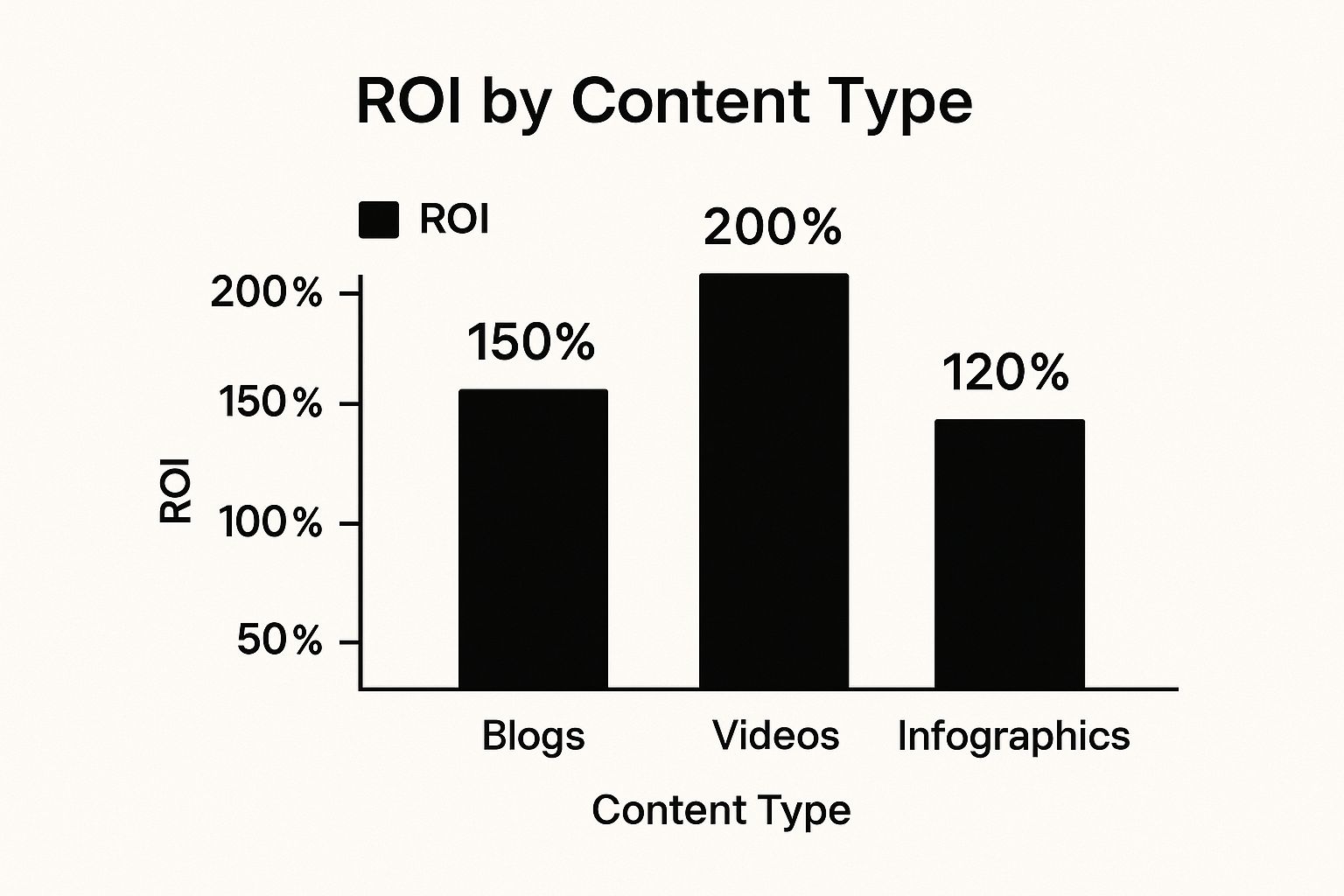Demystifying Content Marketing ROI: Beyond the Basics

Calculating the return on investment (ROI) for content marketing can be challenging. Traditional ROI calculations often focus on immediate sales, which doesn’t fully capture the value of content marketing. Content marketing builds brand awareness, nurtures leads, and develops long-term customer relationships. These benefits are not always immediately quantifiable, requiring a more sophisticated approach to ROI measurement.
Moving Beyond Vanity Metrics
Many marketers focus on vanity metrics like page views and social media likes. While these metrics offer some insight, they don’t tell the whole story about content effectiveness. A blog post with thousands of views but no conversions isn’t helping your bottom line. Instead, concentrate on business-driving indicators.
Some important business-driving indicators include:
- Lead generation
- Sales conversions
- Customer lifetime value
This shift in focus connects content efforts to tangible business outcomes.
The Dual Nature of Content
Content acts as both a short-term conversion tool and a long-term brand asset. Well-crafted content can drive immediate sales through targeted calls to action. Consistently producing high-quality content positions your brand as a thought leader and builds trust with your audience. This trust influences future purchasing decisions. Therefore, it’s crucial to measure both the immediate and long-term effects of your content.
Content marketing is a highly effective strategy. It generates three times more leads than outbound marketing while costing 62% less. Additionally, 82% of customers have a more positive view of a company after interacting with its content, demonstrating the impact of content on brand loyalty. This efficiency is vital for maximizing ROI. Find more detailed statistics here.
Building a Framework for Measurement
Establishing a clear measurement framework from the beginning is essential. This involves several key components:
- Defining your goals: Determine what you want your content to achieve. Examples include increasing brand awareness, generating leads, and driving sales.
- Identifying key performance indicators (KPIs): Choose the metrics that will accurately track progress toward your goals.
- Implementing tracking mechanisms: Decide how you will collect and analyze data using tools like Google Analytics. Consider using UTM parameters for more detailed tracking.
By focusing on the right metrics and building a robust measurement framework, you can demonstrate the value of your content and unlock its full potential. This structured approach will allow you to refine your content strategy and prove its effectiveness to stakeholders.
Metrics That Actually Matter: Tracking Content Performance

Vanity metrics can be misleading. To genuinely understand content marketing ROI, focus on key performance indicators (KPIs) directly tied to business results. This means moving past likes and shares to analyze how content influences each stage of the customer journey. The data chart above visualizes the ROI of various content formats, demonstrating the importance of tracking the right metrics. As you can see, case studies provide the highest return, making them a valuable investment for content marketers.
Measuring Across the Funnel
The most important metrics change depending on where your audience is in the sales funnel.
At the top of the funnel (TOFU), the goal is brand awareness and reach. Key metrics include website traffic, social media reach, and brand mentions. A successful TOFU blog post, for example, might drive substantial organic traffic, boosting brand visibility.
At the middle of the funnel (MOFU), the focus shifts to lead generation and engagement. Metrics like lead magnet downloads, email sign-ups, and time spent on page become vital. This stage is all about nurturing potential customers. A compelling call to action within a case study, for instance, can generate more demo requests.
At the bottom of the funnel (BOFU), the main objective is conversions and sales. Here, track metrics like sales conversions, customer lifetime value (CLV), and close rates. A product demo video that effectively addresses customer pain points and showcases product value can significantly improve sales conversions.
To provide a more detailed overview of metrics across the funnel, let’s examine the following table:
Content Marketing Metrics by Funnel Stage
A comprehensive breakdown of relevant metrics organized by customer journey stage
| Funnel Stage | Key Metrics | Measurement Tools | ROI Significance |
|---|---|---|---|
| TOFU | Website traffic, Social media reach, Brand mentions | Google Analytics, Social media analytics platforms | Builds brand awareness and expands reach |
| MOFU | Lead magnet downloads, Email sign-ups, Time spent on page | Marketing automation platforms, CRM systems | Nurtures leads and qualifies prospects |
| BOFU | Sales conversions, Customer lifetime value (CLV), Close rates | CRM systems, Sales dashboards | Drives revenue and customer acquisition |
This table provides a structured approach to understanding which metrics to prioritize at each stage of the customer journey. By focusing on these metrics, businesses can effectively track the performance of their content marketing efforts.
Content Format and Measurement
Different content formats require different measurement approaches. Blog posts are often evaluated based on organic traffic and lead generation, while videos are assessed based on watch time and social shares. Webinars, alternatively, might be measured by attendance rates and post-webinar conversions. Each format offers unique advantages and requires tailored measurement strategies.
Tracking Implementation: Connecting the Dots
To fully understand content marketing ROI, implement a system connecting content consumption to buyer behavior. UTM parameters, for example, can track conversion sources, revealing which content pieces contributed to a sale. Using a customer relationship management (CRM) system offers valuable insights into customer interactions and sales conversions stemming from content. These tools provide a vital link between content engagement and revenue, facilitating data-driven decision making.
Calculating Real Content ROI: A Practical Framework

Calculating the ROI of your content marketing requires a structured approach. This involves a deep understanding of your investment, diligent tracking of key performance metrics, and accurately attributing returns. This framework helps clearly demonstrate the financial impact of your content efforts to stakeholders.
Accurately Accounting For Investments
Calculating your content marketing investment involves more than just the upfront cost of content creation. It includes all associated expenses, such as:
- Production Costs: Writer fees, designer fees, and video production costs.
- Distribution Costs: Social media advertising spend and email marketing software subscriptions (Mailchimp)
- Optimization Costs: SEO tools (Semrush), A/B testing software, and analytics platforms like Google Analytics.
- Other Indirect Costs: Team member salaries and overhead expenses.
For example, if a campaign involves blog posts, social media promotion, and email marketing, each channel’s costs should be meticulously tracked and added together. This provides a true picture of the overall investment. Often overlooked costs, such as the time spent on content strategy and planning, should also be factored in.
Implementing Multi-Touch Attribution
Most customer journeys involve multiple interactions with your content. A customer might discover your brand through a blog post, then engage with a social media ad, download a lead magnet, and finally make a purchase after receiving an email. Multi-touch attribution models help determine how much each touchpoint contributed to the final conversion. This provides a more realistic view of content’s role in the sales process.
Various attribution models exist, ranging from first-touch (crediting the first interaction) to last-touch (crediting the final interaction). There are also more complex models like linear or time decay. Choosing the right model depends on your specific business and sales cycle.
Quantifying Immediate and Long-Term Value
Content marketing delivers both short-term and long-term value. Blog posts may drive immediate leads and sales, while consistent content creation builds brand awareness and customer loyalty over time. A strong content marketing ROI framework considers both.
Immediate returns, like lead generation and sales, are generally easier to quantify. However, long-term value, such as increased brand awareness and customer lifetime value, should also be measured. Tracking metrics like brand mentions and repeat purchase rates can demonstrate the lasting impact of your content strategy. Consider how email marketing delivers an average $42 ROI for every $1 spent, showcasing the importance of nurturing leads over time.
Adaptable Frameworks and Persuasive Presentation
Different business models require different ROI calculations. E-commerce businesses might focus on conversions and average order value, while B2B companies might prioritize lead generation and sales pipeline growth. Content marketing ROI also varies across content types, with formats like blog posts, videos, and infographics impacting different funnel stages.
Having flexible frameworks and persuasive presentations tailored for different stakeholders is essential. These frameworks should clearly showcase how content directly contributes to both immediate and long-term business objectives. By highlighting this dual nature of content and presenting ROI data transparently, you can effectively communicate its value and secure buy-in for future content initiatives.
Technology That Transforms Content ROI: Beyond Basic Analytics
Technology is essential for maximizing your content marketing ROI. While basic analytics platforms provide a foundation, maximizing your content’s performance requires more sophisticated tools. These technologies help navigate common measurement challenges and unlock new ROI opportunities.
The Power of AI in Content Marketing
Artificial intelligence (AI) is transforming how marketers create, distribute, and measure content. AI-powered tools enable personalized content experiences, automate distribution for broader reach, and deliver more profound performance insights. This helps marketers understand what content truly connects with their target audience.
This understanding allows for optimizing future campaigns for better results. The benefits include higher engagement, increased conversions, and a greater content marketing ROI. For instance, AI can analyze user data to predict high-performing topics and formats, focusing marketing efforts on the most impactful strategies. AI also automates tasks like social media posting and email campaigns, freeing marketers to concentrate on strategic initiatives.
The increasing importance of AI is evident in current adoption rates. By 2024, 67% of small business owners and marketers used AI for content marketing or SEO. Marketers using AI saw an average ROI increase of 70%. Plus, 68% of businesses reported improved content marketing ROI because of AI integration. Explore this topic further.
To further illustrate the impact of AI implementation, let’s examine a comparison of key ROI metrics before and after AI integration. The following table summarizes the average percentage improvements observed across various metrics.
AI Implementation Impact on Content Marketing ROI
| Metric | Pre-AI Average | Post-AI Average | Percentage Improvement |
|---|---|---|---|
| Website Traffic | 10,000 | 17,000 | 70% |
| Lead Generation | 500 | 850 | 70% |
| Conversion Rate | 2% | 3.4% | 70% |
| Sales Revenue | $100,000 | $170,000 | 70% |
As the table demonstrates, incorporating AI led to a significant 70% average increase across crucial metrics like website traffic, lead generation, conversion rates, and sales revenue. This data underscores the potential of AI to drive substantial improvements in content marketing ROI.
Platforms for Enhanced Attribution
Understanding which touchpoints contribute to conversions (attribution) is a persistent challenge in content marketing. Thankfully, platforms like HubSpot and Google Analytics address this by using multi-touch attribution models. These models provide a comprehensive view of how content influences the customer journey.
This allows businesses to see how various content pieces, from blog posts to social media updates, work together to drive sales. By accurately attributing conversions, businesses gain valuable insights into which content formats and channels perform best, enabling optimized spending and improving overall content marketing ROI.
Implementation Guidance For Varying Maturity Levels
Integrating new technologies can feel overwhelming, especially for organizations at different technological maturity levels. Some businesses might have robust marketing automation, while others are just beginning with basic analytics. Resources and strategies are available for every level.
Organizations starting their journey should focus on core tracking mechanisms like UTM parameters and setting up Google Analytics. More mature organizations might consider integrating AI-powered content optimization and personalization platforms. Focusing on incremental improvements and strategic technology adoption, regardless of your current level, will drive measurable ROI growth.
Case Studies and Real-World Examples
Many businesses have leveraged these advanced technologies for substantial content marketing ROI improvements. Some companies significantly increased lead generation using AI-powered personalized content recommendations. Others streamlined content distribution through automation, broadening their audience and boosting brand awareness.
These case studies offer practical strategies for leveraging technology to enhance content marketing effectiveness. By studying these successes, businesses can identify the technologies and approaches that align with their specific goals and industry, allowing them to implement similar strategies and achieve comparable ROI improvements.
Conclusion
Strategically adopting the right technologies provides a deeper understanding of your content’s impact and maximizes ROI, resulting in more effective campaigns, increased revenue, and achieving your marketing objectives.
Breaking Through Content ROI Barriers: Solving Real Challenges

Demonstrating content marketing ROI is a common challenge. Many marketing leaders, however, have successfully overcome these obstacles. By understanding their strategies, we can address the most persistent difficulties.
Navigating Attribution Complexity
One of the biggest challenges is attribution, particularly when using multiple marketing channels. Customers rarely convert after just one interaction. A typical customer journey might involve reading a blog post, seeing a social media ad, downloading a lead magnet, and finally making a purchase after receiving an email. This complex process makes it difficult to pinpoint the exact impact of content. Fortunately, practical solutions exist.
Multi-touch attribution models assign credit to each touchpoint in the customer journey, painting a more realistic picture of content’s influence. Technology plays a key role in tracking and managing content ROI. Investing in a robust CRM system offers valuable insights into customer interactions, connecting content efforts with sales. Using UTM parameters allows for tracking specific campaigns and content pieces, revealing their contribution to conversions.
Demonstrating Value in Long Sales Cycles
B2B sales cycles are often long, making it difficult to link content to immediate revenue. Instead of focusing solely on immediate sales, emphasize value throughout the entire customer journey. Track key metrics such as lead generation, engagement with sales materials, and movement through the sales pipeline.
This data highlights how content nurtures leads and contributes to long-term revenue growth. For example, demonstrate how content influenced qualified leads and potentially reduced the sales cycle, even if the final conversion takes time.
Building Executive Buy-In
When content results are not immediate, securing executive buy-in can be a challenge. Start by agreeing on meaningful success metrics with stakeholders. Clearly explain the long-term benefits of content marketing, including increased brand awareness and customer loyalty.
Focus on data-driven storytelling. Show how content contributes to customer lifetime value, highlighting its long-term financial impact. Executives value metrics tied to business goals. Present data clearly and concisely, linking content efforts to overall business objectives. Regular progress updates maintain transparency and build confidence in your content strategy.
Addressing Data Limitations and Building Credibility
Data limitations can hinder demonstrating content marketing ROI. However, even with imperfect data, you can build credibility. Focus on the data you do have. Track engagement metrics and connect them with feedback from sales teams. This shows content’s value even without precise attribution.
Clearly explain your methodology and be transparent about data limitations. This builds trust and demonstrates a commitment to accurate reporting. Prioritize creating a comprehensive measurement framework over time, continually improving data quality.
Building Your Content ROI Optimization Engine
Measuring content marketing ROI isn’t the finish line; it’s the starting point. Calculating your ROI is just the first step in a continuous improvement cycle. This section explores creating a system for ongoing optimization, using data-driven insights to enhance your content’s effectiveness and drive even stronger returns.
The Feedback Loop: Measurement Informs Strategy
High-performing content marketing teams establish a strong feedback loop between measurement and strategy. They use data from ROI calculations to inform future content creation and distribution decisions. For example, if a particular blog post series generated a high ROI, analyze what made it successful. Was it the topic, the format, or the promotion strategy? Replicate successful elements in future content. This ongoing feedback loop ensures your content strategy continually evolves and improves based on measurable results.
Content Audits: A Health Check for Your Content
Regular content audits are like giving your content a health check. A content audit systematically reviews all existing content to assess its performance and relevance. This identifies:
- Content that’s performing well
- Content that needs improvement
- Content that’s no longer relevant and should be removed or updated
A content audit provides a clear picture of your content landscape, highlighting optimization opportunities.
Testing and Iteration: The Path to Improvement
A/B testing is a cornerstone of content optimization. It involves creating two versions of a piece of content with slight variations, then tracking which version performs better. You might test different headlines, calls to action, or images. Continuously testing and iterating based on data insights allows you to progressively refine your content for maximum impact.
Data-Driven Resource Allocation
ROI data should drive your resource allocation decisions. If a particular content format consistently delivers a high ROI, allocate more resources to that format. If a channel or content type consistently underperforms, consider reducing investment in that area. This data-driven approach ensures your resources are allocated to the most effective strategies.
Cross-Functional Alignment: Building a Culture of Content Value
High-performing content teams build cross-functional alignment around content value. They share ROI data with other departments, like sales and product development, to demonstrate how content contributes to overall business objectives. This shared understanding of content’s value builds buy-in and ensures content is integrated into the broader organizational strategy.
Building this culture of optimization is a continuous process. By constantly analyzing data, testing new approaches, and adapting your strategy based on results, you can ensure your content marketing engine drives increasingly stronger returns over time. Ready to transform your content marketing ROI? ReachLabs.ai can help. We provide data-driven strategies and creative solutions designed to meet your unique business objectives. Visit us today to learn more.





